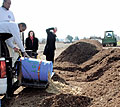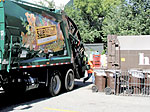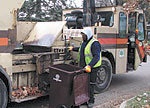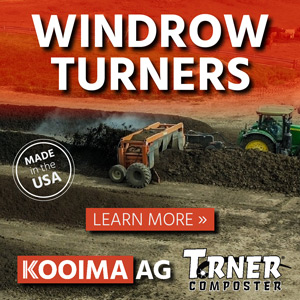 BioCycle January 2009, Vol. 50, No. 1, p. 23
BioCycle January 2009, Vol. 50, No. 1, p. 23
A multitude of approaches based on traditional refuse collection equipment are currently in use.
Craig Coker
WHAT is the most efficient way to move source separated organics (SSO) from the generator to a composting facility? The answer to that question is complex, and depends on the nature of the SSO being collected, logistical or regulatory requirements for collection frequency, space considerations at the point of generation, the distance to the composting facility and costs of alternative collection vehicles. SSO includes yard trimmings, food scraps, manure and bedding, and a broad array of industrial solid wastes such as sludges, out-of-date foodstuffs and manufacturing wastes. And that range of materials originates from an equally diverse list of generators, such as local mom-and-pop restaurants, schools and universities, and national corporations with multiple manufacturing facilities in the U.S. Those generators are located virtually everywhere, from small rural areas to crowded urban locales.
All of these factors impact the type of collection container used, which can be as small as a 30-gallon blow-molded polyethylene cart or as large as 40-cubic yard compactors, with an assortment of sizes in-between. And container choices must be made in conjunction with decisions on a collection vehicle. This article investigates options for SSO collection, looking at methods in use around North America.
TYPES OF TRUCKS
Traditional refuse trucks are classified as automated, semiautomated, rear-loading (both traditional and retrofitted with cart tippers), front-loading, and side-loading. Automated trucks have electro-mechanical arms for reaching out and picking up containers or dumpsters, whereas semi-automated trucks require a worker to move the container into a position where the automated pickup system can work. Some are designed for emptying dumpsters and others are designed for emptying carts (or toters).
Trucks for hauling compactors and roll-off dumpsters can be either cable-lift or hook-lift. Modular or compartmentalized (split-body) trucks are used to collect curbside recyclables, which can include SSO. At the smaller end of the scale, pickup trucks and box trucks equipped with hydraulic tailgates are used (the author used a tailgate-equipped box truck to move food scraps in 96-gallon wheeled carts several years ago for the Special Olympics in Raleigh, North Carolina). A Canadian company (VQuip, Burlington, Ontario) distributes a line of modular collection trucks (HaulAll) on a pickup chassis. Truck bodies can be changed out depending on the nature of the SSO collection containers.

Some SSO collection programs have a single generator of food scraps, which simplifies collection For instance, the Four Seasons Hotel in Philadelphia, Pennsylvania, produced 213,178 pounds of food scraps from approximately 400,000 meals served in 2007. These scraps are hauled 37 miles to Two Particular Acres, a farm-based composting operation in a neighboring county, in a F350 pickup truck (fueled by biodiesel) in rolling 35-gallon totes (EcoCart, by Cascade Engineering, Grand Rapids, MI). “We spend about 4 cents/pound [$80/ton] to haul and recycle our food scraps, whereas our normal solid waste costs are more like 6 cents/pound [$118/ton],” says Marvin Dixon, who is both Director of Engineering for the hotel, and owner/operator of the food scraps hauling truck. “We have found that our customers like the fact that we recycle food scraps, so we’re going to tie our environmental sustainability program into future marketing efforts to appeal to potential environmentally conscious guests.”

Campus dining halls are increasingly implementing SSO collection and composting programs. Consider the University of Virginia (UVa), which just started a SSO diversion program in November 2008 at one of its dining halls. According to Jess Wenger, the EMS Coordinator for UVa: “At the University of Virginia, a food waste composting operation was recently initiated for the Observatory Hill Dining Hall. Food waste and paper products from dishes and the kitchen are run through a Hobart (Troy, OH) Model WR1000 pulper that grinds and dewaters the material. The pulp is discharged directly into 30-gallon plastic barrels, which are capped and sealed for transport. We expect to produce three barrels per day on average. Using the lift on the loading dock, the barrels are loaded onto a pickup truck or box truck owned by UVa Recycling, and taken to Panorama Farms, a farm-based composter located approximately eight miles away. The truck is backed up to an existing windrow, and the barrels are tipped over from the tailgate. No manual lifting of the full barrels is required. The pulped material is then covered and incorporated into the windrow.”

INDUSTRIAL ORGANICS
At the opposite end of the SSO spectrum, a 50,000 tons/year industrial generator of papermill sludges in Virginia has contracted with Royal Oak Farm, a 150,000 tons/year composting facility. Sludges are loaded into Trinity Trailer’s stainless steel 60- and 90-cy belt conveyor floor trailers for transport 35 miles to the composting facility, with 10 to 20 trips/day at all hours of the day and night. Royal Oak provides around-the-clock waste hauling for several industrial sources. “We have to be available to them 24/7, so that waste doesn’t backup in the plant and cause it to shut down,” says Ken Newman, General Manger of Royal Oak Farm. “If they call at 3 A.M., then sometimes I have to get out of bed and run the truck.”
Royal Oak Farm uses hook-lift trucks to pick up compactors and tankers containing SSO from three food processing plants near its composting facility, which is either composted or recycled directly into animal feed. “We decided to go with hook-lift trucks instead of cable-lifters for two reasons,” says Newman. “Our drivers don’t have to get out of the truck to pick up a load, and we often have to back our compactors into designated spaces inside buildings. It’s just easier to do that with a hook-lift truck because using a cable-lift is like pushing on a string.” However, he notes that the heavier truck frame needed for hook-lift mechanisms limits his load capacity – 20-cy Marathon compactors are used for most feedstocks, but a 3,500-gallon tanker is used for liquids.
The Royal Oak’s compactors are loaded by plant staff through a hopper, using either a cart dumper or manually emptying 30-gallon containers. The compactors are equipped with rubber gasket-sealed rear tailgates, which Newman notes are watertight up to 42 inches deep so that leakage onto the road is not a problem. “We still don’t use them to haul wet or sloppy materials because when we pick them up, the material will slop out the back,” he says. The tankers are filled by a pumping system at one facility, but are also equipped with vacuum pumps rated at 15-inch mercury. The Sterling hook-lift truck has been outfitted with an extra axle and wheels to handle heavier loads. Royal Oak has truck drivers wash out the compactors after every load and thoroughly steam-cleans them twice a year. The hook-lift truck is operated by one employee. Cost of transportation limits this service to a 30 to 40 mile radius from the facility. One drawback to this method of SSO collection is that contamination is often not detected until the container is unloaded at the composting facility.
CONTRACTED HAULING
Not all composters have their own fleet for feedstock collection. “We contract our hauling and/or contract with haulers,” says Bob Yost, Vice-President of A-1 Organics in Colorado. “Most of them are using front loader packer trucks and self-contained compactors for food waste. We receive wood materials in standard roll offs and on occasion end-dump trailers. A few of the haulers are starting to use the side-loading lifter to handle totes.” A-1 takes food waste along with waxed and non-waxed cardboard, soiled paper and scrap wood. “We grind it all with previously ground wood,” explains Yost. “We have to add moisture, as it is rarely a good mix, moisture wise. We are getting more wet streams though now and that may change. The haulers have to return to the route for separate collection of MSW, so that is a downside.”
Using outside haulers means an increased risk of contamination at the composting facility, because haulers have little incentive to reject a pick up due to contaminants. One method of controlling this is a penalty charge for rejected loads. “If they are contaminated to the point where it takes more than 10 minutes to remove trash, we reject it and charge them a hefty fee to take it to the landfill,” Yost says. The City of Denver is targeting 3,000 households for residential SSO diversion, so A-1 is considering getting into the hauling business for feedstocks, which will allow them to make modifications to the trucks so operators can inspect the material before it gets deposited in the truck. “Commercially, we feel you need a minimum of 150 tips per week to make it viable, although that may include multiple containers at a single site,” he adds.
TRADITIONAL HAULERS TAP ORGANICS
 Traditional waste haulers and recyclers are increasingly expanding to collect SSO, bringing a different set of tools to the task. Save that Stuff, for instance, is a multifaceted recycling company in Charlestown, Massachusetts (near Boston). Founded in 1990, it recycles paper, bottles and cans, cardboard, and recently expanded into food scraps collection for composting (see “Partnerships Move Commercial Organics Collection Forward,” BioCycle August 2007). It collects more than 2,000 tons/month of reusable and recyclable material. For collecting SSO, it uses a 2006 Mack truck equipped with a 25-cy McNeilus rear load packer body, which uses a cart tipper. This allows the driver to inspect the load as it’s going into the truck. “For our next truck, we’re thinking about going with a truck body like the ones used to pick up materials for rendering plants,” says Adam Mitchell of Save That Stuff. “In hotter months, we’ve noticed that the food waste will spill out of the back of the truck, especially with wetter scraps.”
Traditional waste haulers and recyclers are increasingly expanding to collect SSO, bringing a different set of tools to the task. Save that Stuff, for instance, is a multifaceted recycling company in Charlestown, Massachusetts (near Boston). Founded in 1990, it recycles paper, bottles and cans, cardboard, and recently expanded into food scraps collection for composting (see “Partnerships Move Commercial Organics Collection Forward,” BioCycle August 2007). It collects more than 2,000 tons/month of reusable and recyclable material. For collecting SSO, it uses a 2006 Mack truck equipped with a 25-cy McNeilus rear load packer body, which uses a cart tipper. This allows the driver to inspect the load as it’s going into the truck. “For our next truck, we’re thinking about going with a truck body like the ones used to pick up materials for rendering plants,” says Adam Mitchell of Save That Stuff. “In hotter months, we’ve noticed that the food waste will spill out of the back of the truck, especially with wetter scraps.”
Animal bedding is collected, which Mitchell notes is key to “plugging” the load when it gets wet. Some modifications were made to the McNeilus body, including adding a Vishay SI Technologies “Route Man” on-board scale, modifying the cart tipper with a rubber flap to prevent dripping when the carts are emptied, and adding additional seals on the hopper to prevent leakage.
Save that Stuff collects food scraps from four towns around Boston and takes them to one of three composting facilities within 25 to 30 miles of its office. It tries to get 15 tons/day on the truck to meet financial targets. The truck is usually about 80 percent full when a route is complete. Food waste is collected in 32-gallon Brute Rubbermaid containers and in 68-gallon Otto carts. Two employees staff the collection truck; clients are responsible for keeping the collection carts clean.

Another traditional waste hauler in New England is taking a different approach to collecting SSO. Global Environmental Services, a subsidiary of John’s Refuse and Recycling in New Haven, Connecticut, uses a vacuum truck to collect SSO. The company services only commercial accounts at this time, including municipalities, schools, restaurants, hospitals and nursing homes. “Our truck is a 2004 Freightliner with a ‘Vac-All’ body, which used to be made by Leach,” says Andy Bozzuto, President of Global Environmental. “We chose this truck because we wanted to ensure cleanliness, with no leakage onto streets, driveways, parking lots, etc. We also wanted the ability to collect yard waste along with the food waste. This type of body is commonly used for storm-drain cleaning and dirt/liquid sweeping, so we decided that it would be perfect for food waste – the body is vacuum sealed to prevent any type of leakage.”
Global Environmental accepts commingled food waste, yard trimmings and cardboard, which the company requires customers to cut into 10-inch by 10-inch pieces. “By mixing the yard waste and waxed cardboard with food waste, not only are we providing a wet/dry mix for composting, we are also absorbing the food waste liquid and even further reducing the chances of any leakage,” continues Bozzuto. Global’s truck is customized with a portable Fairbanks 2200 scale to accurately weigh each food waste container collected and emptied. The truck is also equipped with sweeping and wash-out capabilities in the rare case that leakage occurs. Global uses 32-gallon and 65-gallon containers to collect the food and yard waste. Rather than being “loaded” onto the truck, each container is vacuumed out with an extendable hose on the back of the truck.
The average weight of a full food-waste container is 150 lbs in the 32-gallon, and 300 lbs in the 65-gallon. Each full container is placed on the truck’s scale, weighed, taken off the scale, vacuumed out, and put back on the scale for a final measurement. The weight is recorded, and a weight ticket is printed for the customer. Global makes sure each container is cleaned after pickup. “When the toter is vacuumed, the suction is so strong that the liquid residual left behind in the toter amounts to less than a teacup worth,” says Bozzuto. “However, the truck is also equipped with a water tank and hose. Toters are washed out right on site and vacuumed dry.”
Global’s truck operators are instructed to keep a watchful eye on the material being vacuumed. Toters provided have a list of acceptable and nonacceptable items right on the lid, with more detailed lists on the company website. Customers can put biodegradable dinnerware in with food waste, but it must be certified by the Biodegradable Products Institute (BPI). Food scraps are then hauled to Garick Corporation’s New Milford Farms composting facility, about 60 miles away. Bozzuto indicates that it takes about 100 containers to fill up the truck, which has a capacity of 10 tons/load.
MUNICIPAL COLLECTION
 Some municipal governments are involved with SSO diverson and collection. For example, the city of Ann Arbor, Michigan collects and composts about 20,000 tons/year of yard trimmings and food waste. It uses Lodal T-25 side load packer trucks that became available when the city automated its refuse collection and purchased new trucks. The Lodal trucks pick up yard trimmings from between 300 and 500 homes on a one-square-mile collection route (out of about 1,500 total homes per route). In all, about 24,000 homes participate in the curbside collection program. A small amount of food scraps are picked up along with yard waste, which makes up the bulk of the material collected, according to Tom McMurtrie, an Environmental Systems Analyst with the City’s Public Services Department. Most of the food scraps collected by the City are from commercial sources.
Some municipal governments are involved with SSO diverson and collection. For example, the city of Ann Arbor, Michigan collects and composts about 20,000 tons/year of yard trimmings and food waste. It uses Lodal T-25 side load packer trucks that became available when the city automated its refuse collection and purchased new trucks. The Lodal trucks pick up yard trimmings from between 300 and 500 homes on a one-square-mile collection route (out of about 1,500 total homes per route). In all, about 24,000 homes participate in the curbside collection program. A small amount of food scraps are picked up along with yard waste, which makes up the bulk of the material collected, according to Tom McMurtrie, an Environmental Systems Analyst with the City’s Public Services Department. Most of the food scraps collected by the City are from commercial sources.
Ann Arbor sells collection carts to residents via its web page. “We use Cascade carts,” says McMurtrie. “Most of the carts are 96-gallon, although we use some 35-gallon and 64-gallon carts.” The Lodal trucks are semiautomated, normally run by one employee, meaning the worker has to get out of the truck and roll the cart to the lifting mechanism (two employees are used on heavier routes). The contents of the cart are then mechanically dumped into the truck. There is no mechanism for cleaning the carts, leaving that up to the cart owner. Weights are recorded when the trucks get to the City’s material recovery facility, which is near the composting facility. No modifications have been made to the Lodal trucks for handling SSO. McMurtrie notes that the food scraps portion of the SSO is such a small a percentage of the total that they have not noticed any issues with leakage from the trucks.
A well-developed SSO diversion program is in the Region of Peel, Ontario, which is part of the Greater Toronto Area. The Region of Peel is made up of cities of Brampton, Mississauga and the Town of Caledon, covering an area of 1,254 square kilometers, and has a population of 1,159,405. In April 2007, the Region launched a weekly SSO recycling program, collecting household food scraps and soiled paper in 12-gallon Norseman Green Bins. In July 2008 participation was over 50 percent; the average amount collected was 125 Kgs (275 lbs) per household per year.
Two different waste hauling contractors collect the residential SSO (along with blue box recyclables) and deliver them to one of the two composting facilities in the region. One contractor uses a 32-cy Universal Handling Equipment rear packer on a Freightliner chassis with a dual tailgate and 75/25 split body with a driver and a collector; the other contractor uses a 34-cy Labrie Expert 2000 dual tailgate 60/40 split body side loader. Split body trucks are used to collect 14-gallon blue box recyclables along with 13-gallon green bin compostables. Two persons staff each truck.
“The collection routes vary from 800 to 1,000 stops each per day,” says D. Trevor Barton, the Acting Waste Management Program Manager for the Region. “Typically, the trucks empty at the MRF/Compost Facility twice per day. We only collect from 300,000 curbside residential single detached homes, up to a six-plex multifamily unit in size. We do not collect from the commercial sector, except in the five Business Improvement Areas in the downtown cores, where there is a unique mix of residential and commercial properties.” Collection days are Monday to Thursday and run north to south.
Once the truck reaches the MRF/Composting Facility, in-bound weight (tare) is recorded at a weigh scale and the truck drops off the single stream recyclables. The truck then proceeds to a remote scale, weighing in to establish a transitional tare with the organics payload. After organics are dropped off at the composting plant tip floor, the truck exits on the outbound scales.
Curbside collection bins in the Region of Peel are not cleaned by the truck drivers. “Residents can line bins with BPI approved certified compostable bags, sheets of newspaper or paper bags,” explains Barton. Incoming materials are inspected for contamination prior to being loaded. “Nonrecyclable blue box materials are left behind in the blue box for the resident with a note, and there is an inspection when the green bin is opened,” he continues. “If the collector sees noncompostable plastic bags, the entire bin is left behind with a note.”
As diversion of SSO to composting (and potentially energy recovery) is still in its infancy, it’s not surprising that a multitude of approaches based on traditional refuse collection equipment are being used. Over time, the evolution of strategies, technologies and equipment specific to SSO collection is inevitable, driven in large part by the need to minimize handling costs.
Craig Coker is a Contributing Editor to BioCycle and a Principal in the firm of Coker Composting & Consulting near Roanoke, Virginia (www.cokercompost.com). He can be reached at cscoker@verizon.net.
January 25, 2009 | General










